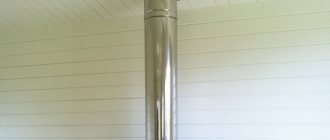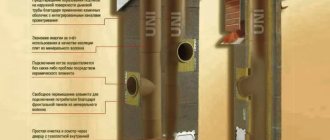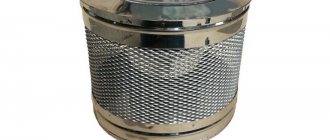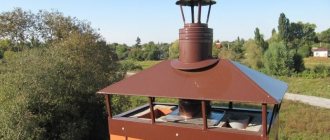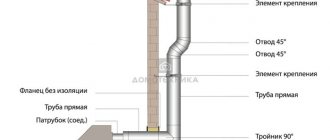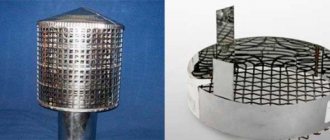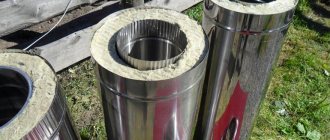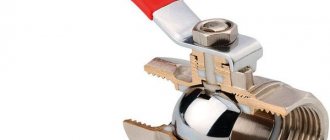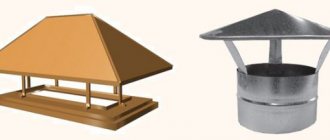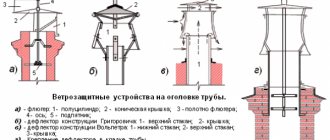Hello dear reader! We love to relax outside the city, but in the cold season our favorite dacha needs to be heated. Modern stoves differ significantly from their ancient counterparts, primarily in ease of use and efficiency, but at the same time they are more demanding in terms of fuel quality and design features.
Chimneys for long-burning stoves have some specific design requirements. In our article we will talk about installing chimneys for long-burning heating units with our own hands.
What is it and what is it for?
A chimney is a device for discharging fuel combustion products into the atmosphere. It usually takes the form of a pipe installed vertically near the heating unit or mounted on it.
At the same time, it isolates gases from flammable materials and building structures. Smoke removal protects housing and residents from fire and carbon monoxide poisoning.
How the chimney works
For modern long-burning furnaces, traditional brick pipes are practically not used. Modern chimneys made of ceramics or sandwich pipes have modules for connection to the stove, for collecting condensate, vertical, and for cleaning. Ceramic structures have an external frame made of expanded clay concrete, mineral wool insulation in the gap between the ceramic pipe and the frame. Sandwich pipe modules consist of an outer and inner steel shell and insulation between them.
There must be a deflector on top of the chimney.
Chimneys for stoves - main features and differences
The chimney for a long-burning stove has a fairly simple structural structure and is made in the form of a vertical pipe. Its top is equipped with a protective device against atmospheric influences and an inspection window for maintenance work. The design also includes a tray for collecting and discharging acidic condensate formed from flue gases. The basic part of the structure is a vertical pipe; the safety conditions and operating efficiency of the heating source will depend on its geometric dimensions.
In modern long-burning boilers, thanks to the underlying heating principle, a high level of efficiency is achieved, about 90% or even more. The heat removal from the combustion chamber is quite significant and ensures a low-temperature regime of flue gases at the outlet of the furnace. In connection with this, boilers of this modification do not have requirements for the heat resistance of the smoke exhaust system. At the same time, these structures have another problem - the formation of oxygen-containing condensate. The higher the temperature of the exhaust gases, the more moisture it will carry into the atmosphere. At a temperature in the flues of about 55 C, a phenomenon appears - the dew point, when moisture begins to be released from the flue gases and combustion products dissolved in it in the form of various acids: nitric, carbonic and sulfuric.
At subzero outside temperatures, this process is especially effective, especially if the gas ducts are laid along the external wall of the house. As a result, acid flows abundantly down their walls. In the case when the flues are made of building materials that absorb moisture, such as brick or fireclay, such an aggressive liquid will quickly destroy the internal chimney systems. Therefore, for boilers, chimneys are made of materials that are highly acid-resistant: acid-resistant brick, ceramics or stainless steel.
Types and designs
Types of chimneys based on material of manufacture:
- brick;
- metal - single-layer and three-layer with insulation;
- asbestos-cement;
- reinforced concrete;
- ceramic.
Types of chimneys by design:
- wall - traditional brick structures made of red brick, integral with the wall. The bottom of the structure rests on the foundation of the wall;
- indigenous - a free-standing structure that has a separate foundation, most often located outside near the wall of the house, most often brick with a liner or ceramic;
- mounted – installed (attached) to a stove or fireplace and are light in weight. In practice, single-layer metal chimneys or sandwich pipes are installed using this method;
- modern prefabricated steel structures suspended from supporting structures and without foundations;
- we can also mention the coaxial structures of two pipes of the Shidel system, in which incoming air and exhaust gases flow in countercurrent (the most famous example is horizontal pipes used to connect gas boilers).
Advantages
Residents of particularly frosty regions, using a long-burning wood stove for heating, note its high qualities/advantages:
- safety and ease of use;
- low wood consumption, high efficiency;
- external attractiveness.
A wood-burning stove designed for long-term combustion provides constant heat and serves as a stylish element of the interior of a country house. TMF sells its products throughout Russia and the CIS, there is delivery from our online store throughout the Russian Federation (including Moscow, St. Petersburg, Voronezh, Nizhny Novgorod, Rostov-on-Don, Yekaterinburg, Novosibirsk, Khabarovsk).
Which one is better to choose?
When people talk about long-burning stoves, they usually mean solid fuel boilers using a wide variety of fuels:
- firewood;
- pellets;
- peat;
- coal.
Most often we are talking about all kinds of wood-burning metal stoves, fireplace stoves, buleryans with the main method of transferring heat into the room by convection.
Modern equipment has an efficiency of 87% for pyrolysis units to 92% for pellet units. The fuel burns almost completely, releasing some sulfuric, nitric and other acids and a lot of moisture. When not very hot exhaust gases rise, they cool against the walls of the chimney and fall out in the form of aggressive condensate.
Old brick and asbestos-cement chimneys are not very resistant to acids and require the installation of an internal stainless steel liner. In addition, they need to be additionally insulated - and insulation at altitude is not very convenient. If possible, it is better not to use such chimneys.
In principle, single-layer steel structures cannot be used without insulation - condensation will ruin the stove, and in cold weather it can completely extinguish the fire in the firebox. With insulation, installation is difficult and troublesome, but not very expensive. But not for long – for a maximum of 10 years.
The best option is ceramic structures and “sandwich”. They have high acid resistance, a very long service life, corrosion resistance, a smooth internal surface, good thermal insulation, a large range of ready-made factory-made modules, quick installation, and easy repairs. The sandwich is light in weight. A serious advantage of ceramics is durability (up to 50 years) and the ability to withstand high temperatures. Both types of structures can be installed both inside and outside the building. Disadvantages: considerable price, ceramics are quite fragile and have relatively complex installation, requiring a foundation.
The best choice is ceramics or sandwich. Buy - with a guarantee in a construction supermarket.
The outer shell of the sandwich should not be 0.5-0.7 mm thick - only 1 mm (should not bend when pressed by hand).
Types of chimneys depending on material
Not only the safety of living in the house, but also the efficiency of the boiler unit will depend on the extent to which the smoke exhaust system design is professionally completed. Errors made during the design and installation of a chimney reduce its efficiency from 90 to 60% and even lower. At the same time, the specific fuel consumption for the production of thermal energy increases, and in addition, the heat source cannot provide the proper level of heating of the premises. For this reason, it is necessary to decide in advance what kind of building material the smoke removal system will be made of. You will also need to correctly determine its height and cross-sectional area, and the installation point.
Brick chimney pipe
Brick pipe for a chimney
Traditional brick has been used for a long time for the construction of chimneys and gas ducts, but for boilers with long-burning fuel it cannot be considered a good solution due to low acid resistance. If such a modification of the boiler is installed in a house where gas flues already exist, then the problem with smoke condensate is solved by installing a stainless steel pipe inside the flues.
If the owner of the boiler remains committed to brick chimneys and has decided to build them during the construction of a house, then in this case it is possible to line the inner surface of the channels with acid-resistant bricks or similar building materials.
There is another problem with brick flues that the owner of a long-burning boiler will have to solve - abundant soot deposition. Since the brick surface has increased roughness, soot intensively settles on it, which gradually clogs the passage of chimneys, especially in areas with lower speeds of flue gases: turns, wells and outlet channels. Cleaning and preventive maintenance of brick pipes is a labor-intensive task and sometimes requires the help of a specialized organization.
Chimney made of steel pipe
Stainless steel chimneys
For long-burning boilers, it is preferable to install steel pipes, however, it must be non-corrosive, heat-resistant and acid-resistant. The thickness of the walls of such structures must be at least 1 mm. The factory-made steel chimney system consists of straight sections and various shaped units. It can be installed independently or integrated into existing brick flues.
Based on the structural location of the house, boiler unit and climatic characteristics of the location area, one of the following options for metal flue ducts is used:
- Single-wall stainless steel construction with round cross-section. The simplest and cheapest model.
- Single-wall stainless steel structure of oval cross-section, used for reconstruction of existing brick flues.
- Double-walled sandwich panels - 2 steel pipes with inter-pipe insulation in the form of basalt wool. This design reduces the formation of condensation inside the structure, and therefore their external installation on the facade of the house is allowed.
- Coaxial steel chimney, made according to the “pipe-in-pipe” principle. There is no insulation between them, and the inter-tube annular space is used for air intake, which increases the efficiency of the boiler. However, despite their innovation, such systems are not recommended for long-burning boilers unless additional measures are taken to remove condensate.
Condensate collector in the flue
Chimney made of asbestos-cement pipe
More recently, such chimneys were used wherever possible, despite the fact that, according to their characteristics, they were not even initially intended for such purposes. Their advantages include only a low price, but there are disadvantages, especially when used for long-burning boilers so many:
- Rough surface on which soot quickly accumulates. In large volumes, it can become a source of ignition, and an asbestos pipe can simply explode.
- Low acid resistance; in addition, acidic condensate impregnates the chimney material, comes out, spoils the appearance, and over time becomes a source of its destruction.
- The heavy weight of the structure, due to which it is necessary to perform complex installation;
- poor quality sealing of joints.
Considering the technical characteristics of such a chimney, experts categorically do not recommend using it for long-burning boilers.
Ceramic chimney pipe
Ceramic chimney
Many experts consider ceramic pipes to be the most suitable for long-burning boilers, and their main advantages include:
- Long service life;
- resistance to aggressive acid condensates;
- the smooth surface does not allow soot to linger;
- highest endothermic parameters;
- endurance to high temperatures.
To increase the scope of application of ceramic chimneys, they are produced in a metal casing; they can also be produced in a form with a rectangular cross-section. The first of them do not require the construction of foundations and the production of specific channels, while the second are well used for the reconstruction of gas ducts made of bricks.
Vermiculite chimney pipes
Vermiculite chimney pipes
This is a new type of chimney, the most reliable for long-burning systems, since it is made of stainless steel. Their inner surface is additionally treated with an acid-resistant mineral vermiculite with a 5 cm layer. In addition to its ability to withstand acid-containing condensate, the material has low thermal conductivity, which classifies it as a natural heat insulator.
Other positive qualities of vermiculite steel pipes include very high durability, comparative ease of installation, and no need for additional chimney insulation. There is also a drawback - the rough inner surface of the chimney allows for the accumulation of soot, for this reason it will have to be cleaned quite often.
Make it yourself or order it
The solution to this issue depends on many factors:
- having at least minimal construction skills;
- presence of at least two assistants;
- roof structures - installation on flat roofs is much easier;
- chimney designs;
- and even if you have a fear of heights.
The ideal choice is the most progressive sandwich and ceramics. The sandwich is much simpler to assemble and easier to install yourself: ceramics are more fragile, the presence of a foundation and an outer box complicates the work - it is better to entrust its installation to professionals.
Making pipes yourself is nonsense. You can lay a brick pipe with your own hands - but this is quite difficult; not every mason can lay even vertical masonry. Asbestos concrete and steel pipes with insulation can be installed yourself, but this is a bad choice.
A little physics
Without knowing why and how smoke moves, making a chimney for a stove with your own hands is problematic; at a minimum, it may not be effective enough.
The mechanics here are quite simple: warm air has a lower density than cold air, and therefore less weight, therefore, according to the laws of physics, it “floats”, being pushed out by the heavier one.
Smoke from the chimney
During this process, it gradually cools down, mixes with the surrounding air and, finally reaching the same temperature, stops.
If we let warm air through a channel limited by walls that prevents it from mixing with the surrounding air, it will cool much more slowly, especially if the chimney for the stove is made of a material that does not conduct heat well or is additionally insulated.
The longer the chimney, the greater the volume of warm air in it, the greater the force it creates. Accordingly, the pressure of the air flow - thrust - is greater.
Building regulations
The installation of chimneys is determined by the provisions of SNiP 41-01-2003.
The chimney design must meet the following regulatory requirements:
- the minimum height must be at least 5 meters from the combustion point or grate;
- the pipe must rise above the flat roof to a height of at least 1 meter;
- when located on the roof slope at a distance of less than 1.5 m to the ridge, the pipe should be 0.5 m higher than the ridge;
- when located on the roof slope at a distance of 1.5-3 m to the ridge, the pipe may not be lower than the ridge;
- when located on the roof slope at a distance of more than 3 m to the ridge, the angle between the horizontal and the line passing through the ridge and the top of the pipe should be no more than 10°;
- the maximum length of each horizontal and inclined section should not be more than 1 m, the total length of their projections onto the horizontal should not exceed 2 m. If there are oblique and horizontal sections, it is necessary to extend the pipe by the length of the horizontal projections. For ceramics, horizontal sections are not allowed.
Fire safety requirements for chimneys
The distance from the surface of ceramic, insulated steel and asbestos-cement chimneys to combustible house structures must be at least 0.25 m; for brick chimneys and sandwich pipe structures - at least 130 mm.
It is necessary to protect building structures made of combustible materials using cement or gypsum plaster on a mesh with a thickness of at least 25 mm.
If the roof is covered with flammable materials (roofing felt, bitumen tiles, ondulin), or leaves or fluff can accumulate on it, a spark arrestor made of mesh should be installed on the head of the pipe.
Traction force
Factors influencing traction force:
- height of the structure;
- condition of the internal channel - smoothness of the walls, regularity of soot removal;
the presence of inclined or horizontal sections. For pipes of long-burning units, the presence of horizontal and inclined sections is not allowed, since the exhaust gases have a low temperature and lengthening the chimney is undesirable - the gases will cool, the draft will decrease until they tip over;
- installing a deflector;
- quality and thickness of insulation;
- air supply to the firebox.
Your safety depends on the presence and strength of traction, so you need to check the presence of traction and take measures to clear the channel of soot and icing of the pipe head.
Correct assembly sequence
- First, connect the outlet pipe of the boiler or stove to the lower element of the chimney - a single-layer uninsulated pipe. It can consist of several modules and be vertical, horizontal or bent by 45 or 90 degrees.
- To switch to an insulated pipe, use an adapter. It is put on an uninsulated pipe, coating the joint with a special sealant that can withstand temperatures up to 1300 degrees Celsius.
- Further assembly is done with your own hands from insulated elements. They are inserted into each other so that the upper part fits over the lower part. The top can be determined by the edge of the pipe - it is wavy, which makes joining easier. With this installation, the internal channel is connected “along the smoke”, that is, the direction of the joints is located so as not to interfere with the smoke flows inside. All elements are connected with heat-resistant sealant.
According to the location of installation, smoke exhaust systems are divided into internal, passing through the interfloor ceilings and roof, and external, located near the outer wall of the building. In this case, the chimney outlet is made through the wall of the house or bathhouse.
- The part passing through heated rooms can be made of a single stainless pipe - its surface becomes very hot when fuel burns and additionally gives off heat. When passing through an unheated attic in a house or bathhouse or outside, the chimney requires mandatory insulation, so sandwich modules are used for this part of it.
- A direct chimney can rest directly on a heating device - a stove, a pellet boiler. If there are branches or bends, it is necessary to install support platforms at the floor level, at least every 5 meters.
- When installed externally, the system is secured using wall fastenings - brackets with clamps. They are sold complete with chimneys. The lower part of the chimney is supported by a cantilever bracket.
- The pipe is equipped with cleaning facilities in places convenient for access. They are a tee with a plug placed on the outlet. If necessary, remove the plug and inspect and clean the smoke channel from soot. A plug with a condensate receiver is installed at the bottom of the pipe.
- The greatest attention should be paid to passages through walls, ceilings and roofs. For them, special modules are used: “passage through the ceiling” and “passage through the roof”. The top of the pipe is equipped with an umbrella to ensure fire safety, improve draft and ventilation.
In a wooden house
Before installing a smoke removal system with your own hands, you need to study the fire safety requirements for chimneys installed in a wooden house.
- In addition to the above, they have a number of features:
- the distance from the uninsulated chimney to any combustible surfaces must be at least 25 cm horizontally and 80 cm vertically;
- passages of the chimney through the roofs must be carried out using passage units - metal boxes filled with heat-insulating material, usually basalt mats;
- in the case of connecting several smoke channels into one, it is advisable to place the vertical chimney in a separate box made of non-combustible material, for example, foam concrete.
An inspection of all sections of a stainless steel chimney in a wooden house must be carried out at least twice a year!
If external damage, discoloration of steel, or rust is detected, you must ensure the integrity of the inner pipe - it could burn out! Simple designs of smokehouses for cold smoking and methods for their manufacture at home and on the go can be found here. All stages of manufacturing a smoke generator for cold smoking are described in detail in the following article:
In the bath
The bathhouse is a place of increased fire danger. The heating of wooden surfaces in a bath reaches 90-100 degrees, and the temperature at which wood begins to char is 120-150 degrees with prolonged exposure. Wooden elements located near the chimney heat up the most. Therefore, fire safety distances must be strictly observed.
Making and installing a chimney with your own hands
We will not consider installing galvanized and stainless steel pipes with insulation - this is already the last century.
What materials are best to make it from?
The choice of optimal material is described above. You cannot make a sandwich or ceramics with your own hands.
Here we will look at do-it-yourself installation of the most advanced ceramic pipes, which also have the most complex installation. Sandwich pipes have modules that are similar in purpose and design to ceramic ones, and their installation is not particularly difficult. The main thing is not to forget to coat the joints with sealant and additionally insulate the passages through the ceiling and roof.
Drawing and diagrams
The life of the residents of the house depends on the parameters of the pipe. Therefore, you cannot start work without a drawn drawing or at least detailed diagrams! Before starting work, it is necessary to carefully measure the height of the room, attic, and ceilings. Then make a diagram or drawing and determine how many and what components you will need.
It would be a good idea to put all the information into a table - this will help with purchasing.
Size calculation
The height of the pipe is determined taking into account the height of the building and the requirements of SNiP 41-01-2003 (see above).
Based on the diameter of the outlet pipe of the heating unit, we determine the internal diameter of the chimney - they must be equal.
Installation video
All the details of ceramic and sandwich installation can be seen in our video.
Installation features
The procedure for installing a ceramic chimney:
- the foundation for installing the pipe must be perfectly level - no distortions during installation are allowed;
- To seal the seams between the modules, a special acid-resistant solution is used. Dilute it in accordance with the instructions on the package in small portions immediately before use - otherwise it will harden by the end of installation work;
- an external expanded clay concrete casing is installed on the foundation;
- insulation and reinforcing elements are inserted into it; It is convenient to cut them into pieces of 1.5 m each. If it is necessary to connect two reinforcing rods, they are simply inserted into the holes in the housing blocks with an overlap of at least 100 mm. Holes with reinforcing rods must be filled with cement mortar;
- the joints of the body blocks are also fastened with cement mortar;
- a module with a condensate tank and a pipe for its drainage is installed;
- in the future, the pipe elements are mounted in the same order - body, insulation, ceramics;
- if necessary, holes are cut in expanded clay concrete elements using a grinder;
- then a module with an inspection door or a tee for cleaning is mounted;
- then a tee is installed to connect the boiler or fireplace;
- then the pipes are installed;
- excess solution should be wiped off with a wet sponge;
- When passing through the roof, the pipe is secured using special clamps.
After installation of all structures, decorative finishing of the external expanded clay concrete body and installation of the deflector are carried out.
What happens in the oven?
The combustion process from a chemical point of view is a process of oxidation, in other words, the combination of substances and oxygen with the release of heat.
Combustion process in a furnace
The result of the reaction, in addition to heat, will be the appearance of new compounds, as well as the transition of some fuel substances into gaseous form. At the same time, in accordance with the law of conservation: how many substances by weight enter into the reaction, the same amount should be “output”.
If the fuel is solid (coal, firewood, peat, etc.), the lion's share of the remaining weight will be the ash remaining in the furnace. In addition, we will get steamy water, carbon dioxide, etc.
By burning gas or liquid fuel, the output will be carbon dioxide, water vapor and a set of other gaseous compounds. There will be practically no solid residue.
Frequent errors and problems during installation
The most significant and dangerous mistake is the absence of a deflector or at least a cap over the chimney. Snow and rain should not get inside the pipe - they increase the formation of condensation, and ice can block the cross-section of the pipe.
If the chimney goes to the roof in the same block with ventilation ducts (there is such a modification - both the chimney and the ventilation pipe pass in one building), then the chimney should be higher than the ventilation one, preferably by 500 mm.
In places where structures pass through ceilings, it is strictly forbidden to install joints of individual elements - leaking hot smoke can cause a fire.
Maintenance and cleaning
Regular cleaning of chimneys will prevent fires and draft overturning. The frequency of cleaning is 2 times a year. You can carry out mechanical cleaning, you can use the chemical method - burn special products in the firebox. But it should be taken into account that these special logs burn at a very high temperature and contribute to faster burning of the chimney.
It is necessary to promptly remove ice and icicles frozen on the top of the pipe - they reduce draft and there is a danger of carbon monoxide poisoning.
Long-burning wood stoves for home use: pros and cons
Long-burning boiler design
A characteristic feature of such heating devices is the slow combustion of solid fuel. In fact, it smolders in the combustion chamber, and the volatile substances released from the fuel burn. This process is made possible by regulating the volume of air entering the combustion chamber. It is divided into 2 working compartments and is completely sealed. The volume of the combustion space is quite impressive, allowing you to add fuel that ensures the operation of the boiler from several hours to several days. The duration of work on 1 tab occurs due to the specifics of the combustion process. Due to the lack of oxygen, the fuel burns very slowly, while capturing new underlying layers.
The advantages of long-burning boilers include:
- Compactness and light weight lead to savings on the purchase and installation of the unit;
- the ability to regulate the intensity of fuel combustion;
- high level of efficiency for solid fuel boilers, efficiency 85 – 90%;
- modern design, due to which the unit is harmoniously integrated into any room;
- multifunctionality - the ability to work on two heating circuits - heating and hot water supply and be used for cooking when installed in a hob design;
- reliable structural components ensure long service life of the unit, many of which have a service life of at least 50 years;
- relatively low price;
- easy operation, since the unit is able to operate for a long time on 1 load of fuel.
However, like all boiler units, this type of boiler also has its disadvantages:
- The need for regular chimney cleaning;
- high requirements for wood moisture content;
- difficulty in setting oven modes;
- low level of automation, due to the inability to instantly stop the combustion process.
